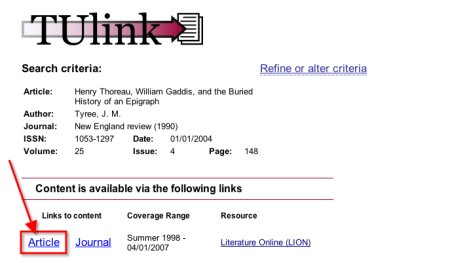JSTOR is the premier scholarly journal database. It is a full-text, interdisciplinary archive of only the most highly respected journal titles. By comparison, ABC-CLIO’s two scholarly databases — America: History & Life and Historical Abstracts— seem to be less frequently used, even by historians. There are several reasons for this, but perhaps the most important is that JSTOR provides direct access to the full-text, full-page image of all articles in the database. Consider, however, the following advantages of the ABC-CLIO databases:
1) America: History & Life and Historical Abstracts between them index over a thousand scholarly journals, including 65 of the 72 history titles available in JSTOR. A researcher using the ABC-CLIO databases will thus find nearly all citations to JSTOR articles and thousands of additional citations not available in JSTOR.
2) The Libraries’ new TUlink service enables two- or three-click access to the full-text of thousands of articles indexed by America: History & Life and Historical Abstracts. This means that JSTOR’s previous “full-text advantage,” described above, no longer holds.
3) Citations to articles in America: History & Life and Historical Abstracts contain human-generated subject headings; JSTOR’s article citations do not. Why does this make a difference? A researcher using the ABC-CLIO databases could perform a subject search for “Gates, Horatio,” easily finding all 34 citations to articles about the Revolutionary War general. This type of search simply cannot be done in JSTOR.
4) JCR Online assesses the impact of scholarly journals on various academic disciplines. The higher a journal’s “impact factor” the more important that journal is within its discipline. Between them, the two ABC-CLIO databases index all sixteen journals identified by JCR Online as having the highest impact factors in History. These journals are: Environmental History, American Historical Review,Journal of American History, Journal of Modern History, Social Science History,Past & Present, Journal of African History, Comparative Studies in Society & History, Journal of Social History, Journal of Interdisciplinary History, History Workshop Journal, International Review of Social History, Ethnohistory, Journal of the History of Sexuality, Zeitgeschichte, and Mouvement Social. JSTOR indexes only twelve of these same sixteen “high impact” history journals.
It certainly is not my objective to sour anyone on the use of JSTOR, which by any measure is a stellar scholarly resource. The point of this post is rather to say that both databases have much to recommend them. The choice of which to use ultimately depends upon the individual needs and preferences of the researcher. A comprehensive history article search will likely require the use of both.
Do you have a favorite history database?

